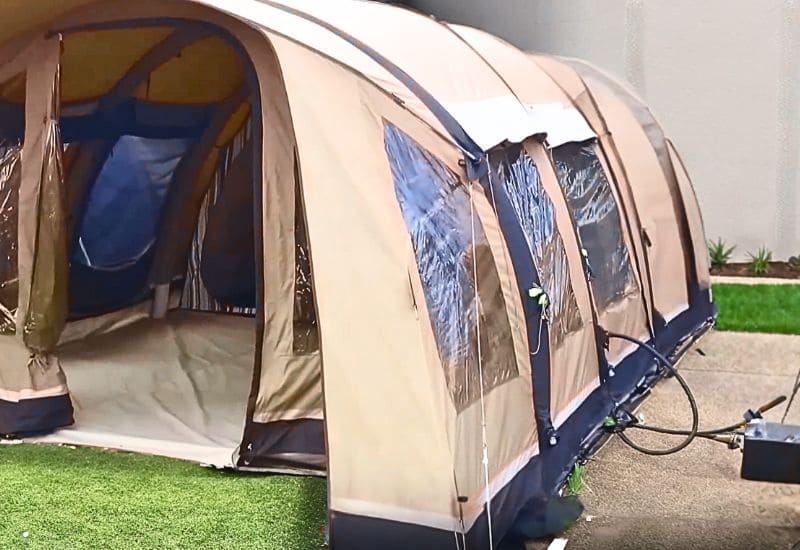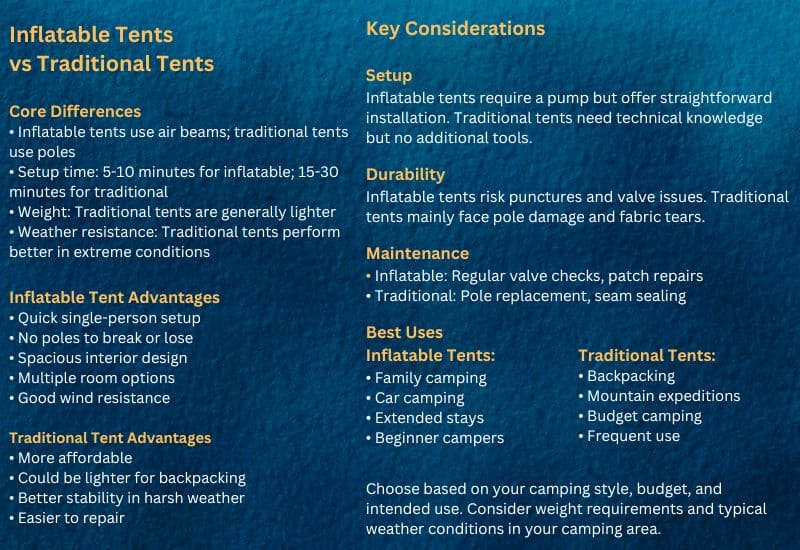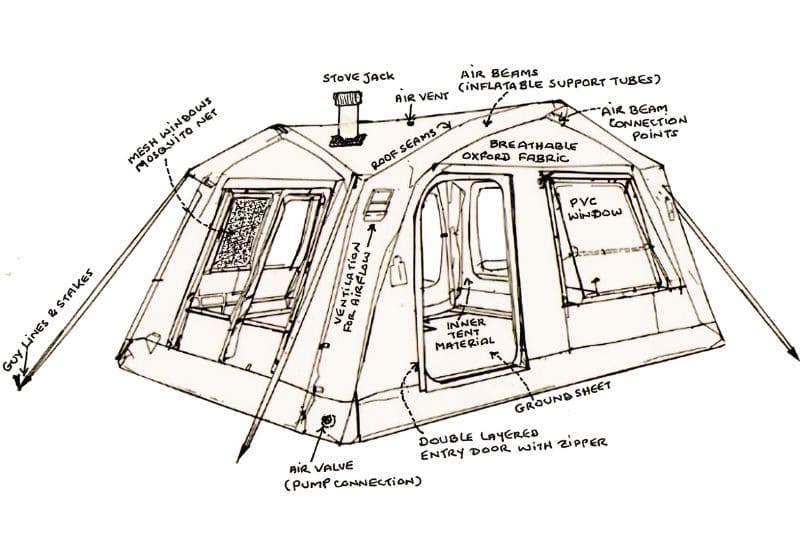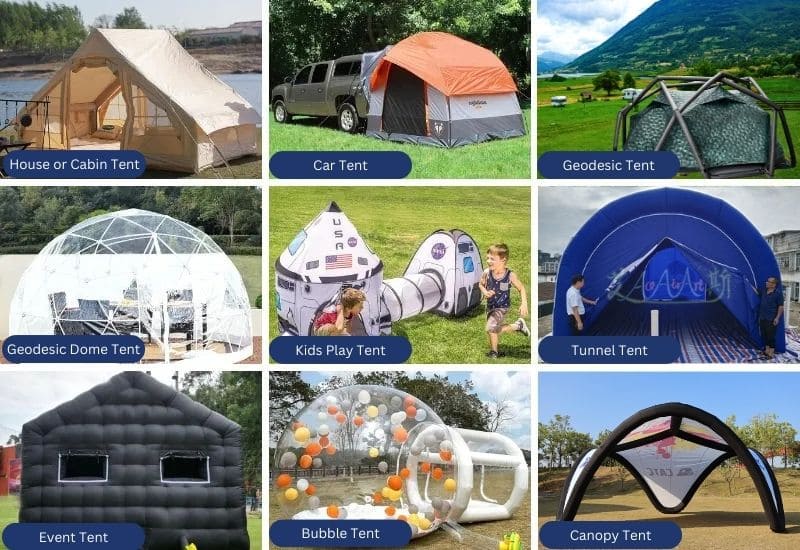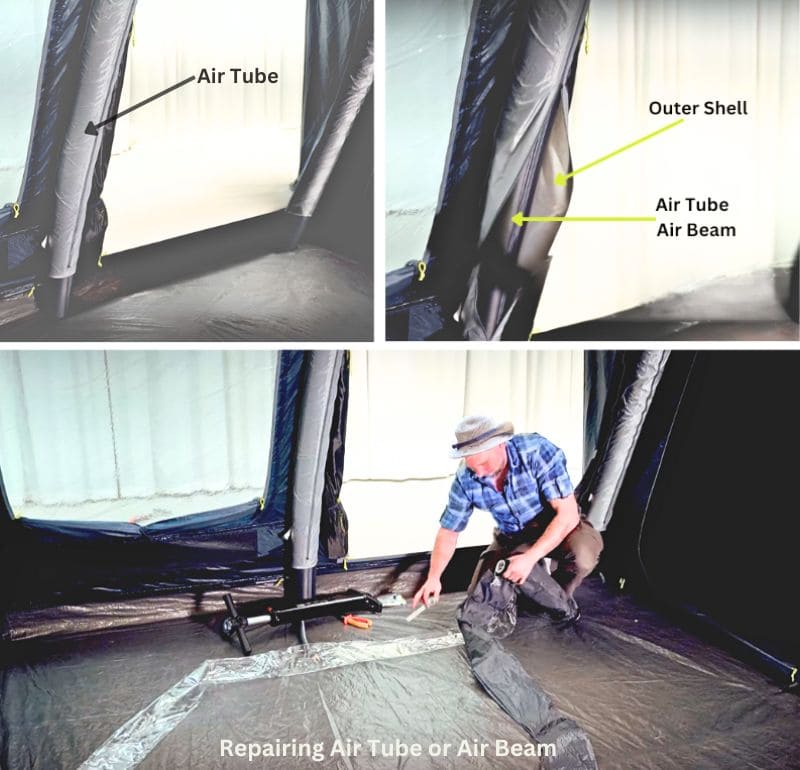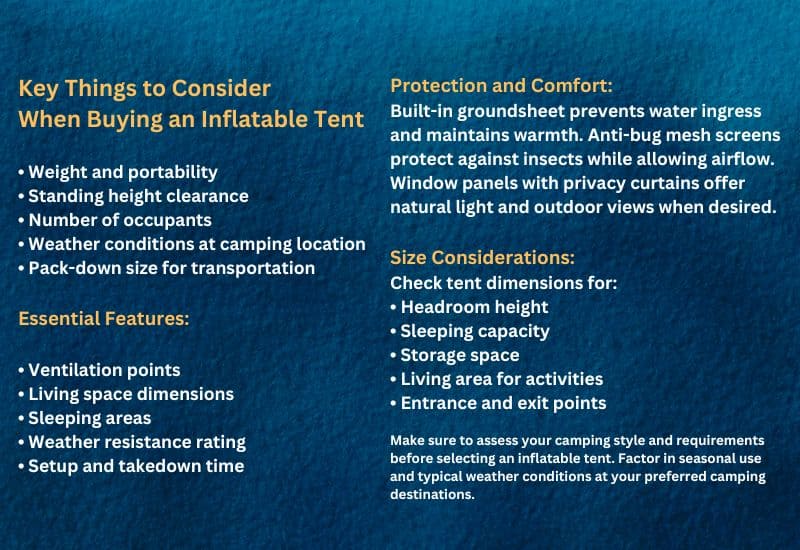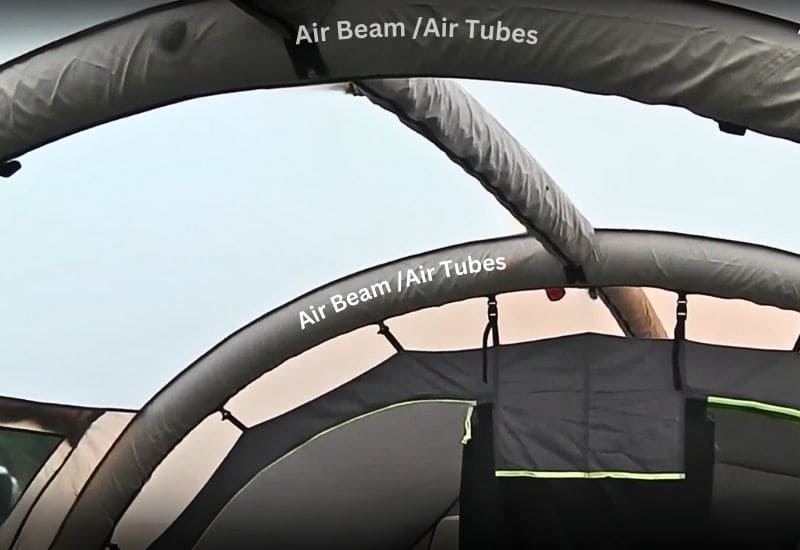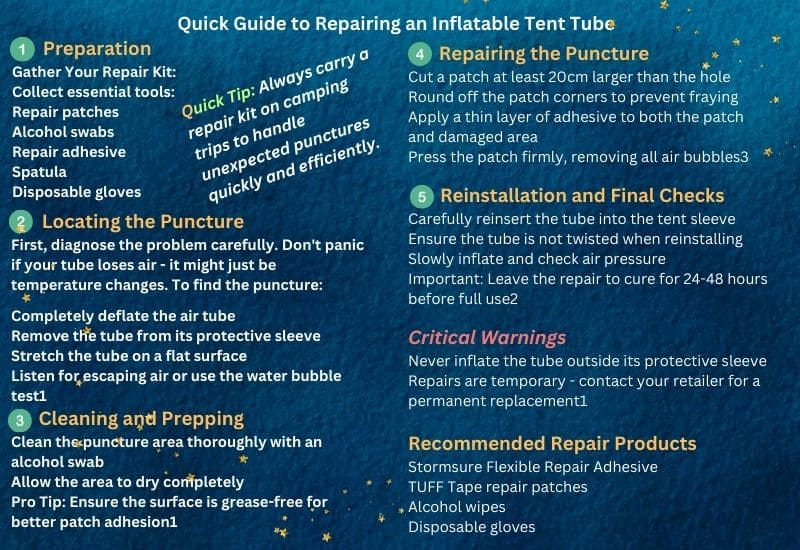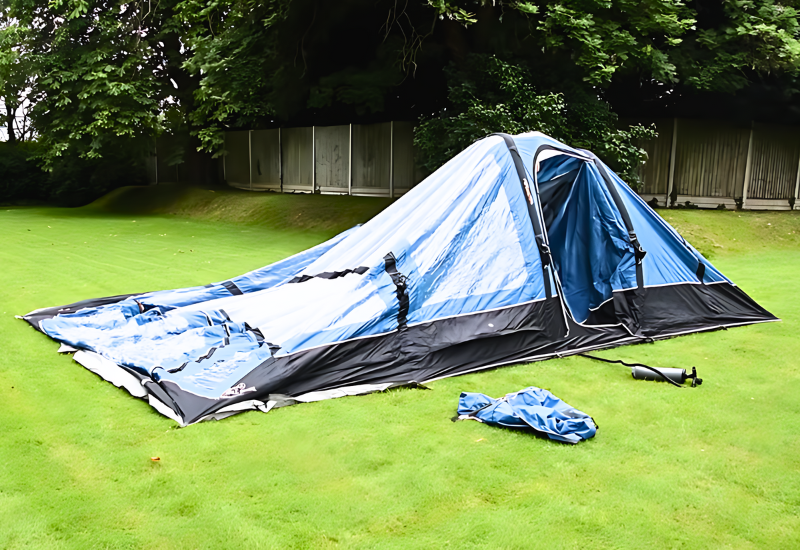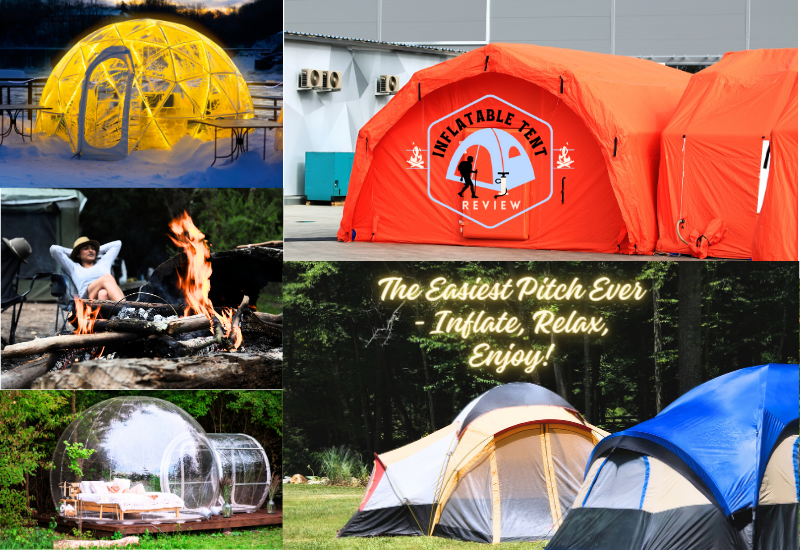Introduction to the Inflatable Tent Guide
An inflatable tent, or air tent, is a cutting-edge solution for camping that uses inflatable beams instead of poles. This guide offers a detailed look at inflatable tents, exploring their types, functionality, and benefits.
Inflatable tents are becoming increasingly popular due to their innovative design and easy setup. By inflating the beams, campers can quickly set up and take down their shelters, making them perfect for outdoor adventures.
When choosing an inflatable tent, consider factors like durability and weatherproof capabilities, especially for unpredictable weather conditions. This guide will help you understand what makes these tents unique and how they might enhance your camping gear collection. So, what’s the best model for your needs?
What are Inflatable Tents?
Understanding Inflatable Tents
What makes inflatable tents stand out in the world of camping gear? Their innovative design replaces traditional rigid poles with integrated inflatable beams, offering a unique approach to camping.
These air beams can be interlinked for stability or inflated individually, ensuring flexibility in setup. Constructed from rugged materials like TPU and PVC, inflatable tents are built to withstand challenging weather, providing both stability and resilience. Additionally, they often come with weather resistance ratings that are measured by hydrostatic head, ensuring reliable shelter during rain.
One of the biggest advantages is the rapid deployment; you can set up your tent in minutes, making it ideal for beginners or those seeking convenience. Quick and easy setup enhances the overall camping experience, allowing you to focus on enjoying your surroundings rather than struggling with assembly.
Plus, their lightweight nature means you won’t be lugging around heavy poles, enhancing portability. Available in various sizes and styles, inflatable tents cater to solo campers, couples, and family camping alike.
Many models come with features like large windows and skylights, maximizing ventilation and natural light. You’ll also find options with partition walls, vestibules, and customizable layouts, allowing you to tailor your sleeping area to your needs.
As you explore inflatable tents, consider factors like fabric quality, waterproofing, and the number of occupants to ensure you pick the perfect fit for your outdoor adventure. Features like groundsheets, awnings, and high-pressure arches add to their versatility and durability. With connectable designs and spacious interiors, these tents provide a unique portable shelter solution. Additionally, look for models equipped with efficient pumps to manage air pressure easily, enhancing the overall functionality of your camping gear.
Features of Inflatable Tents:
- Rapid Setup: Inflatable tents can be set up in a matter of minutes, eliminating the hassle of assembling and pitching traditional tents with multiple poles. Thanks to their airbeam design, these air tents are easy to inflate with a pump, ensuring a quick start to your outdoor adventure.
- Stability: The inflatable beams provide excellent stability and are designed to withstand strong winds, offering a secure shelter for camping enthusiasts. With features such as high-pressure arches and wind resistance, these tents are perfect for family camping and various outdoor adventures.
- Portability: When deflated, inflatable tents are compact and lightweight, making them convenient for transportation and storage. Their design often includes an integrated groundsheet and options for an awning, enhancing the versatility of the portable shelter.
How Inflatable Tents Work
Inflatable tents are designed using a straightforward yet innovative approach. They rely on air to provide both structure and stability. The main components that make these tents functional are:
- Air Beams or Air Poles: Unlike traditional tents that use fiberglass or metal poles, inflatable tents utilize air beams. These inflatable beams create the framework and give the tent its shape.
- Air Pump: Setting up an inflatable tent is easy. An air pump is used to inflate the beams. This process is efficient and eliminates the need for assembling rigid poles. As a result, setup becomes quick and hassle-free.
- Air Valves: Inflatable tents come equipped with air valves for easy deflation. Releasing air from the beams collapses the tent, making it compact for storage and transport.
The quality of materials used in constructing inflatable tents is essential. High-quality fabrics, reinforced seams, and sturdy air beams greatly influence the tent’s performance and durability. When considering an inflatable tent, look for reliable materials to ensure an effective and long-lasting shelter.
Inflatable Tents Versus Traditional Tents
Choosing the right camping tent can be a challenge. Campers often debate between inflatable tents and traditional tents. Each type has unique features and benefits. Understanding these differences can help you make an informed choice.
Key Differences
- Structure: Inflatable tents use air beams for support. Traditional tents depend on poles and fabric.
- Setup Time: Inflatable tents are typically quicker and easier to set up. Traditional tents may require more time and effort.
- Portability: Inflatable tents are often lighter and more portable. This is great for backpacking and hiking trips.
- Stability: Traditional tents usually offer better stability in extreme weather. Inflatable tents can be vulnerable to damage from sharp objects.
Advantages of Inflatable Tents
Inflatable tents provide several notable benefits:
- Quick and easy setup: You can get your tent ready in no time.
- Lightweight and portable design: Perfect for those on the move.
- Less time required to pack and unpack: Spend more time enjoying nature.
- Minimal assembly: Less hassle for campers.
- Excellent resistance to water and wind: Stay dry and protected.
- Excellent stability in harsh weather
- Durable materials
- Maximized interior space
- Insulation for temperature control
- Multiple rooms and panoramic windows
Both inflatable and traditional tents have their pros and cons. Your choice will depend on your camping style and preferences. Whether you favor lightweight convenience or robust durability, there’s a perfect tent for you.
Benefits of Inflatable Tents
Inflatable tents offer numerous advantages for campers. These air tents enhance your outdoor experience in several ways. Their quick setup is a major plus. You can have your shelter ready in minutes, often by yourself. This ease of installation is perfect for new campers.
The compact design of inflatable tents makes them easy to transport. They also provide excellent stability in harsh weather. The flexibility of airbeams helps resist strong winds better than traditional tents. This stability is crucial in challenging conditions. The durable materials used ensure your shelter remains secure.
Comfort is another significant benefit of inflatable tents. Their uniform shape maximizes interior space. Many come with features like multiple rooms and panoramic windows. These tents offer great insulation. They keep you warm on cold nights and cool on hot days. Here are the benefits in short:
Common Challenges and Solutions
Disadvantages of Using an Inflatable Tent
- Prone to Punctures: Inflatable tents are more susceptible to punctures than traditional tents.
- Repairs: Repairing punctures can be more complicated and may need specialized kits.
- Storage Space: They may require more storage space when packed due to air beams and accessories.
- Cost: Inflatable tents can be more expensive upfront, with additional costs for repairs.
Weight and Portability
Inflatable tents come with their own challenges, particularly concerning weight and portability. These tents can often exceed traditional pole tents in heft, sometimes being 30% to 50% heavier. This added weight can make packing them into a single bag rather cumbersome. Moreover, setting up an inflatable tent requires a pump; thus, forgetting the pump can throw a wrench in the entire camping experience. You can read more about the nuances of this in the article on Inflatable tents.
Setup and Takedown
Establishing and dismantling inflatable tents might be more challenging than anticipated, particularly in rainy or wet conditions. Manual pumping can become exhausting during these times, and while you may consider electric pumps, using them in damp weather poses safety concerns. For a more seamless experience, opt for an electric pump equipped with a suction feature. This can facilitate the swift removal of air during take-down. Also, ensure that proper adhesive application is adhered to for effective repairs. Check out more information on this here.
Durability and Maintenance
Durability remains a critical topic when discussing inflatable tents. These tents are often susceptible to punctures, making it imperative to always have a repair kit on hand during camping trips. In the unfortunate event of a puncture, begin by cleaning the affected area. After cleaning, apply glue and place a patch that is at least 30mm wide to ensure a robust fix.
Another challenge to be aware of is leakage, which can result from improperly sealed air valves and may lead to deflation. To avoid this, make it a habit to regularly check for leaks. Feel for soft areas in the air beams and utilize soapy water to locate any problematic areas.
By proactively addressing these challenges, you can significantly enhance your experience with inflatable tents. With the right care and maintenance, these tents can offer a comfortable and dependable shelter for all your outdoor escapades.
Parts of an Inflatable Tent
Know the Key Components of Your Inflatable Tent for a Seamless Outdoor Experience
When it comes to camping gear, an inflatable tent offers a unique blend of convenience and comfort. Understanding the different parts of your inflatable tent is essential. Each component plays a vital role in your outdoor adventure.
Main Components of an Inflatable Tent
Inflatable Beams: The heart of an inflatable tent lies in its inflatable beams. These beams provide stability and support, rivaling traditional poles. Made from durable materials, they withstand various weather conditions.
Tent Fabric: The fabric of your tent is equally important. High-quality, durable, and waterproof materials keep you comfortable and protected. Look for fabrics with a high denier and waterproof rating.
Valves: control the air flow in your tent. They allow you to adjust and maintain internal air pressure, optimizing your setup.
Groundsheet: A groundsheet serves as a protective layer. It keeps moisture at bay and protects against abrasions, ensuring a safe sleeping area for you and your family.
Tent Divider: The tent divider offers privacy while enhancing the versatility of your living space.
Window Screen: A window screen enhances ventilation, keeping insects out while providing a view of nature.
Auxiliary Components
Air Pump: An air pump is vital for easy and quick setup. Whether manual, electric, or battery-operated, it ensures efficient inflation for your tent.
Safety Valves: They help maintain air pressure. They release excess air, keeping the tent stable and secure.
Tube and Tent Sleeves: Tube sleeves protect your inflatable beams, while tent sleeves add support. Together, they contribute to overall tent strength.
Carrying Case: When not in use, a carrying case keeps everything organized and protected, making transport easy.
Stakes and Ropes: They are essential for securing your tent against wind. They enhance stability during your family camping trips.
Spare Parts and Maintenance
Even the best inflatable tents may require maintenance. A repair kit provides the essential tools for on-the-spot fixes. Use a repair patch for any small tears or punctures. Familiarize yourself with these components to maximize your tent’s usability.
Understanding Tent Inflation
Understanding the valve system and inflation process is crucial for efficiently setting up your inflatable tent. Different valve types, such as twist valves and push-button valves, offer varying benefits. Twist valves, used by brands like Vango, lock closed when removed from the pump, ensuring no air escapes. Conversely, push-button valves automatically close when detached, simplifying deflation.
When inflating your tent, consider single vs. multiple inflation points. Single points allow quick inflation but can be less reliable, while multiple points facilitate easier repairs. Ensure the pump connects securely to the valve before starting. Tents utilize a tube and sleeve design for structural integrity, providing added support during inflation. This structural support anchors the tent against adverse weather, enhancing stability.
Comfort and Convenience
Comfort is crucial on your camping trip. Use sleeping pads or air mattresses for added coziness. Tent lights provide visibility at night, while portable fans enhance airflow. Don’t forget blankets or sleeping bags to keep warm.
Weather Protection
Camping in unpredictable weather can be quite the challenge. To ensure you’re prepared, consider adding a rainfly which acts as an additional layer of protection against rain, improving your tent’s waterproofing capabilities. Footprint tarps are excellent for safeguarding your tent’s base from mud and dirt. For windy conditions, windbreaks serve as a shield, helping to keep your tent stable in gusty weather.
On sunny days, don’t underestimate the importance of UV protection covers, as they provide essential shielding from harmful sun rays. Additionally, during chilly nights, an insulated liner can significantly boost warmth and comfort inside your tent.
By familiarizing yourself with the various components and aspects of your inflatable tent, you set yourself up for a seamless and enjoyable camping experience. This includes understanding everything from the air beams to the tent fabric materials, as well as ensuring you have the necessary accessories.
For further details and tips, be sure to check out the complete tent accessories guide.
With this knowledge in hand, you’re well-equipped to assemble, care for, and fully enjoy your inflatable tent during all your family camping excursions.
Types of Inflatable Tents
Inflatable tents have transformed outdoor experiences by offering unmatched convenience and comfort. With a wide range of options available, from tent houses to bubble tents, every outdoor adventurer can find the ideal inflatable shelter to suit their needs. Explore your options and enhance your camping experience with these innovative solutions!
Inflatable Tent House
Inflatable Tent Houses are a remarkable fusion of portability, durability, and spaciousness, ideal for a variety of outdoor adventures. Unlike traditional tents that require extensive setups, inflatable tents can be inflated in a matter of minutes without dealing with cumbersome poles. This innovation not only enhances comfort but also ensures a secure living space during your camping trips. The inflatable design not only provides weatherproof capabilities but also maintains structural stability, making them suitable for various outdoor activities. Explore more about inflatable tent houses here.
Air Beam Tents
Air Beam Tents utilize inflatable beams that revolutionize the camping experience. These inflatable structures allow for a remarkably quick setup while maintaining sturdy support that distinguishes them from traditional pole-based tents. With their versatility, air beam tents are perfect for family camping, solo expeditions, and festivals, offering a reliable and adaptable way to experience the great outdoors. Discover more about air beam tents here.
Geodesic Inflatable Tents
Inflatable Geodesic Tents, characterized by interconnected triangular panels, provide unparalleled stability and durability. The innovative structure offers better wind resistance and a spacious interior compared to regular dome tents. These tents are ideal for camping trips, festivals, and special gatherings, ensuring easy and quick setup without sacrificing comfort. Learn more about Geodesic tents here.
Inflatable Bubble Tent
The Inflatable Bubble Tent presents a transparent, immersive camping experience with panoramic views of the surroundings. This lightweight yet robust design sets it apart from conventional tents, making it suitable for camping, stargazing, and enjoying the beauty of nature. The standout feature of this tent is its ability to provide a 360-degree view, creating a truly memorable outdoor experience. You can read additional details here.
Inflatable Backpacking Tent
Backpacking Inflatable Tents come with inflatable beams instead of traditional poles, resulting in a lightweight, compact, and user-friendly shelter option. These innovative tents prioritize portability and resilience, making them perfect for outdoor enthusiasts who appreciate mobility and quick setup. Ideal for hikers and campers who seek minimal pack weight without compromising comfort, learn more about these tents here.
Inflatable Tunnel Tents
Inflatable Tunnel Tents offer unique elongated designs that maximize space for sleeping, storage, and relaxation. Their easy assembly, coupled with durability and weather resistance, makes them perfect for various outdoor endeavors. With a spacious interior and robust structure, these tents stand out in the camping equipment market for their versatility. Learn more about tunnel tents here.
Inflatable Dome Tents
Inflatable Dome Tents are designed with a distinctive structural framework that ensures exceptional stability and spacious interiors. These tents make setup easy, allowing users to enjoy memorable camping experiences regardless of the weather. They are a practical choice for camping trips, outdoor events, or as emergency shelters during unexpected situations.
Inflatable Canopy Tents
Inflatable Canopy Tents utilize inflatable structural elements to provide exceptional protection against the elements, such as sun and rain. Unlike traditional setups, these utilize air beams for support, allowing for a quick setup and takedown process. Their versatility makes them perfect for camping, beach outings, picnics, and various gatherings. Delve deeper into inflatable canopy tents here.
Inflatable Teepee Tent
Inflatable teepee tents are made with durable materials that mimic a traditional teepee shape, providing ample interior space. Their unique structure allows for a quick and easy setup, while the inflatable design ensures stability and weather resistance—perfect for camping and assorted outdoor activities.
Inflatable Gazebo Tent
Crafted from durable, waterproof materials like PVC or nylon, inflatable gazebos are secured to the ground with stakes and ropes. Unlike traditional gazebos, which require complex assembly, these tents can inflate within minutes using either an electric or manual pump. Their structure remains intact through air pressure within tubular frames, showcasing less susceptibility to damage. Commonly used at outdoor events, trade shows, and festivals, inflatable gazebos offer portability, ease of setup, and a distinctive presence.
Inflatable Event Tent
These inflatable event tents are celebrated for their lightweight yet sturdy construction, making them easy to set up and customize for any gathering. Offering enhanced portability, weather resistance, and a modern look, they cater to a variety of events—from corporate meetings to outdoor festivals. The tents feature rapid deployment options and personalized branding solutions, creating immersive experiences for attendees.
Inflatable Car Roof Tent
Constructed from heavy-duty, waterproof materials, inflatable car roof tents mount securely on a vehicle’s roof. They create a raised sleeping area that is safe from ground-level threats, such as wildlife or flooding. Thanks to their inflatable design, setup and takedown are swift, often facilitated by an included air pump. These tents appeal to travelers and campers seeking a convenient solution that optimizes space and minimizes setup time.
Inflatable SUV Tent
Designed with sturdy materials, inflatable SUV tents include reinforced seams and weather-resistant fabrics for reliable protection. Tailored to fit the back of an SUV, these tents utilize the vehicle as structural support, enhancing stability. Equipped with multiple access points, ventilation windows, and integrated awnings, they provide versatile camping options. Their practical design allows easy attachment to the SUV, transforming it into a spacious shelter equipped for relaxation, storage, and sleeping.
Inflatable Play Tents for Kids
These Kids’ Inflatable play tents are engineered with durable yet lightweight materials, ensuring ease of use and mobility. Featuring inflatable frames and PVC construction, they offer a safe haven for children. These tents provide a playful environment, encouraging imagination while giving parents peace of mind.
Choosing the Right Inflatable Tent
Size and Capacity
When choosing the right inflatable tent, consider size and capacity as crucial factors. Here’s how to assess them:
- Dimensions: Measure the length, width, and height of the tent. Ensure it accommodates the intended number of occupants comfortably.
- Room Layout: Examine the interior layout. Count the number of rooms and sleeping areas. Verify the tent meets your camping needs in terms of space for gear and comfort.
- Capacity Rating: Check the tent’s specified capacity. It’s essential to know how many individuals can comfortably fit. Remember, actual capacity may vary based on the arrangement of sleeping areas.
Key Features to Consider
Choosing the right inflatable tent involves key features affecting your camping experience.
First, durability and weather resistance are vital. Look for a waterproof fabric with a high Schmerber rating. The material should be strong, like polyurethane, to withstand tough weather. Reinforced seams and robust zippers enhance durability. The sealed construction of inflatable tents boosts protection against winds, rain, and snow.
Next is the design and comfort of the tent. Opt for ample interior space with straighter walls for increased headroom. Multiple entrances enhance accessibility, and built-in LED lights offer convenience. Look out for mosquito net windows for ventilation and comfort. Polycotton materials can improve breathability, while weatherproof features contribute to a pleasant camping experience.
Portability is also crucial. Inflatable tents should be lightweight and compact for easy transport. Various sizes are available, catering to solo campers or families. Models that include oversized bags or wheels make transportation even easier.
In summary, an inflatable tent enhances your camping adventures with its innovative features and ease of use. Ensure you select one that aligns with your outdoor adventure needs, whether for family camping or solo trips.
Additionally, it’s essential to evaluate the ventilation, headroom, and overall living space within the tent to ensure a comfortable camping experience.
Below is a table for the required tent area:
| Number of Person | Tent Area
in (M²) |
Tent Area
in (Ft²) |
| 2 | 3 – 4 | 32 – 43 |
| 4 | 5 – 6 | 54 – 65 |
| 6 | 8 – 10 | 86 – 108 |
| 8 | 12 – 14 | 129 – 151 |
| 10 | 15 – 18 | 161 – 194 |
| 12 | 18 – 20 | 194 – 215 |
| 14 | 20 – 22 | 215 – 237 |
| 16 | 22 – 25 | 237 – 269 |
| 18 | 25 – 28 | 269 – 301 |
| 20 | 28 – 30 | 301 – 323 |
Notes:
- The values provided are approximate and can vary depending on the design and layout of the inflatable tent.
- The area requirements include space for sleeping, minimal storage, and some movement.
- For more precise requirements, always refer to the manufacturer’s specifications for the specific model of the inflatable tent.
Portability and Weight
When selecting an inflatable tent, understanding the importance of portability and weight is crucial. These characteristics dictate how effortlessly the tent can be transported and managed, particularly during outdoor adventures. Let’s delve further into this aspect:
- Compactness: A lightweight inflatable tent typically boasts a more compact design, making it easier to pack for activities such as backpacking and hiking. This feature is invaluable for those seeking to minimize their load while on the move.
- Easy Setup: Many of these lightweight options are crafted for a swift, uncomplicated setup process, which significantly cuts down the setup time, allowing you to enjoy your camping experience sooner.
- Material Technology: Innovations in fabric and frame technology have led to the creation of inflatable tents that are both lightweight and durable. This balance ensures that you can enjoy the benefits of portability without compromising on resilience.
- Carrying Options: The latest inflatable tents often feature specially designed carrying cases or backpacks, which further enhance portability and provide practical solutions for storage and transport.
- Trade-offs: It’s vital to weigh the trade-offs between weight and additional features. Some ultra-lightweight tents may prioritize portability at the expense of sleeping area and comfort, so consider your camping needs carefully.
By keeping these considerations in mind, your inflatable tent experience can evolve into one that aligns with your outdoor lifestyle, ensuring that you’re prepared for family camping, intense outdoor adventures, or just a relaxing night under the stars.
Material and Durability
Selecting the perfect inflatable tent involves careful consideration of material and durability. The choice of materials significantly influences the tent’s performance, longevity, and resilience to various environmental conditions. Here’s what you should reflect on:
- Material Types: Inflatable tents are constructed to be lightweight yet robust, ensuring they are both weather-resistant and portable. The materials utilized in various parts of inflatable tents—including the fabric, inflatable tubes, beams, and frames—are specifically engineered for these qualities.
Fabric
- Polyester: This material is commonly favored for the outer fabric due to its toughness, UV resistance, and capability to endure adverse weather. When treated with polyurethane (PU) or silicone, its water resistance becomes even more impressive.
- Nylon: Lightweight and strong, nylon is another popular fabric choice, typically enhanced with PU or silicone for waterproof capabilities.
- PVC (Polyvinyl Chloride) Coated Fabrics: Renowned for their exceptional durability, these materials are waterproof and resistant to both mildew and UV rays, providing superior protection, especially in extreme weather scenarios.
Inflatable Tubes, and Beams
- Thermoplastic Polyurethane (TPU): TPU is often used in the inner bladder of inflatable tubes and beams due to its impressive elasticity, strength, and resistance to punctures and abrasions.
- PVC (Polyvinyl Chloride): The outer portion of the beams and tubes is frequently made from PVC-coated fabrics, which add another layer of durability and environmental protection.
- Drop-Stitch Fabric: This innovative fabric consists of two panels linked by fine threads, allowing for high-pressure inflation and creating a rigid, stable structure upon inflation. Though usually associated with inflatable paddleboards and kayaks, it can also be used in high-performance inflatable tents.
Frames
- TPU and PVC Coated Fabric: The combination of TPU for the inner bladder and PVC-coated fabric for the outer layer is standard for inflatable frames, ensuring the right mix of flexibility, durability, and air retention.
- High-Density Polyethylene (HDPE): Sometimes integrated into frame components for enhanced strength and rigidity.
Reinforcements and Seals:
- Welded Seams: Employing high-frequency or hot-air welding creates robust, airtight seams in inflatable components.
- Reinforced Patches: Reinforcements in high-stress areas, such as corners and attachment points, generally involve additional fabric layers or special patches for added durability.
Additional Features:
- Ripstop Weave: Many polyester and nylon fabrics incorporate a ripstop weave, preventing any tears from spreading.
- UV Protection Coating: Fabrics are often treated with UV inhibitors, extending their lifespan against prolonged sun exposure.
- Flame Retardant Treatment: Certain fabrics undergo treatments to achieve flame retardance, meeting safety standards, particularly for commercial or public use.
- Leveraging these materials and construction methods ensures that inflatable tents deliver dependable shelter across various conditions while remaining easily transportable and quick to set up.
- Seam Construction: Examine the seams of your inflatable tent carefully; durable and well-sealed seams greatly enhance weather resistance and overall durability. Opt for tents featuring welded or taped seams for superior performance.
- UV Resistance: Well-made inflatable tents are designed to provide excellent UV protection. The UV resistance of materials is fundamental for the longevity of your camping equipment.
- Puncture Resistance: A robust inflatable tent should exhibit high puncture resistance, particularly when placed on uneven terrain. Materials that incorporate reinforced designs contribute significantly to puncture resistance.
- Care and Maintenance: To maximize the lifespan of your inflatable tent, regular care and maintenance are crucial. This includes periodic cleaning and storage away from moisture and UV light, following the manufacturer’s guidelines for upkeep.
Weather Resistance
When selecting an inflatable tent, one of the most important factors to take into account is its weather resistance. A well-constructed tent that can endure various environmental conditions will guarantee a safe and enjoyable camping experience.
Here are some key considerations:
- Waterproofing: Search for tents that have a high waterproof rating to ensure protection against rain and moisture.
- Wind Resistance: Choose tents specifically designed to handle strong winds, particularly if you plan to camp in exposed or windy areas.
- UV Protection: Tents manufactured with UV-protective elements shield against sun damage and assist in maintaining a comfortable interior temperature.
In addition, it’s wise to consider the tent’s ventilation features, as they help avert condensation and maintain airflow, especially in humid or warm conditions.
Right Brand to Consider
Selecting the right inflatable tent brand is essential for a reliable and enjoyable outdoor adventure.
Reputable brands often create high-quality inflatable tents that feature innovative materials and construction methods, leading to enhanced durability, weather resistance, and user-friendly setup. When investing in an inflatable tent, it’s crucial to evaluate elements like air pump efficiency, seam durability, and overall design—features that are routinely enhanced in top-tier brands.
These characteristics contribute to both your comfort and safety during wilderness excursions, making your experiences more memorable and fulfilling.
Beyond the material benefits, choosing a respected inflatable tent brand provides the advantage of solid warranties and responsive customer support.
Prominent brands implement rigorous quality control and actively integrate user feedback to continually elevate their products. This commitment to customer satisfaction and product innovation ensures that you acquire a tent tailored to your specific requirements—whether for camping, festival attendance, or a lengthy expedition. In essence, choosing the right inflatable tent brand can transform your outdoor adventures from satisfactory to exceptional.
The Range of Prices for Inflatable Tents
Inflatable tents come at a wide variety of price points, influenced by several factors. Here’s a detailed overview of what you can expect:
- Entry-level Tents: These affordable inflatable tents generally range from $100 to $300. They are ideal for occasional use and may offer fewer features and durability.
- Mid-range Tents: Tents within this category can range between $300 to $800. They strike a balance between cost and quality, providing more features and improved construction compared to entry-level options.
- Premium Tents: The highest tier of inflatable tents typically falls within the price range of $800 to $1500 or more. These are built with top-grade materials, cutting-edge technology, and superior weather resistance, making them suitable for regular and demanding use.
By understanding these price ranges and features, you can make a more informed decision that aligns with your budget and camping needs.
Setting Up Your Inflatable Tent
Inflatable tents, also known as airbeam tents, offer a quick and hassle-free setup, making them ideal for family camping and outdoor adventures. Their portable shelter design combines weatherproof durability with the convenience of easy inflation, ensuring a comfortable and secure sleeping area. For more guidance on setting up your tent, visit Crua Outdoors and TXZ Outdoors.
- When setting up your inflatable tent, start by selecting a flat, clear area to ensure stability and prevent damage. Clear the site of any sharp objects or debris. Lay down a protective footprint to safeguard the groundsheet and avoid water pooling during rain.
- Unpack your air tent and smooth out any wrinkles. Locate the inflation valves, typically on one side or the back, and attach the pump. Begin inflating the tent partially to give it shape, then continue until fully inflated, monitoring the air pressure to avoid overinflation, which could damage the TPU or PVC material.
- Once inflated, secure the tent with stakes or pegs at the corners for added stability. Attach and adjust the guy lines for extra support. Ensure the tent doors are properly aligned and secure any rainfly or additional components as directed by the manufacturer.
By following these steps, you’ll enjoy a seamless setup and maximize the longevity of your inflatable tent.
Factors to Consider When Buying an Inflatable Tent
Practical Factors to Consider When Buying an Inflatable Tent:
When you’re in the market for an inflatable tent, several key factors should guide your decision to ensure you find the perfect one for your outdoor adventures.
- Price: Before starting your search, it’s crucial to set a budget for your inflatable tent purchase. Different models vary significantly in price, so knowing your limit will help narrow down your options.
- Intended Use: Consider the type of camping or outdoor activities you’ll be using the tent for. For instance, if you’re planning family camping trips, you might need a larger airbeam tent with multiple sleeping areas and possibly an awning for additional shelter.
- Features: Determine the essential features you need in your air tent. Key considerations include ventilation, vestibules, interior pockets, and integrated flooring. If you’re looking for a more versatile option, consider tents with partition walls and connectable high-pressure arches.
- Reviews: Research and read reviews from other users to assess the performance and quality of different inflatable tent models. This will give you insights into setup time, stability, and overall durability under various conditions.
- Weather Resistance: Check the tent’s ability to withstand various weather conditions such as wind, rain, and extreme temperatures. Look for features like waterproof materials (such as TPU or PVC), wind resistance due to high-pressure arches, and a robust groundsheet.
By carefully considering these factors, you can find an inflatable tent that meets all your needs for a comfortable and enjoyable outdoor adventure. Whether you’re setting up a portable shelter for a quick weekend getaway or planning an extended family camping trip, making an informed decision will be crucial.
Additional Considerations
- Air Pressure: Ensure that the tent has a reliable air pressure system supported by a durable pump. This is vital for maintaining the structure’s stability.
- Stability and Setup Time: A good airbeam tent should offer quick setup times without compromising on stability. Look for models with secure valves and high-pressure arches that provide excellent wind resistance.
- Versatility and Durability: Opt for tents made from durable materials that are both waterproof and versatile. Features like ventilation systems and integrated flooring can enhance the overall camping experience.
- Spacious Interior: If you’re planning to use the tent for family camping or group outings, ensure it has a spacious interior with ample sleeping area. Some models come with connectable sections or awnings to provide additional space.
By focusing on these aspects, you can select an inflatable tent that not only meets but exceeds your expectations for comfort, stability, and weatherproof performance during your outdoor adventures.
The Material Construction of Inflatable Tents
Material Durability and Performance
Inflatable tents revolutionize outdoor shelter solutions through advanced material engineering and innovative design. The structural integrity of these air-supported shelters depends significantly on the quality and durability of their construction materials.
Critical aspects that determine material durability include:
- Material Engineering: Premium airbeam tents incorporate sophisticated materials like military-grade TPU, double-layered PVC, and specialized polyester composites, delivering exceptional strength-to-weight ratios and remarkable resilience against environmental stressors.
- Structural Integration: Advanced high-pressure arches rely on precisely welded joints and reinforced connection points. These manufacturing techniques create weatherproof barriers while maintaining the tent’s structural stability during challenging conditions.
- Weather Protection: Modern inflatable structures feature multi-layer protection systems, incorporating UV-resistant coatings and specialized treatments that shield against harmful solar radiation, extending the tent’s operational lifespan.
- Surface Defense: Enhanced groundsheet materials and reinforced contact points provide superior protection against ground friction and environmental wear, ensuring sustained performance across diverse camping terrains and weather conditions.
Understanding Design and Purpose
Modern camping has evolved with the introduction of inflatable tents, revolutionizing how outdoor enthusiasts approach shelter solutions. These innovative portable shelters combine cutting-edge design with practical functionality, making them increasingly popular among campers and event organizers alike.
The fundamental architecture of an inflatable tent incorporates several sophisticated elements working in harmony:
- Airbeams: High-pressure arches crafted from TPU or PVC materials form the tent’s backbone, delivering exceptional stability without traditional poles. These airbeams maintain their rigid structure through carefully calibrated air pressure.
- Air Chambers: Sophisticated air compartments work together, creating a network of support throughout the structure. Each chamber maintains independent pressure, ensuring structural integrity even if one section experiences issues.
- Inner Tent: The internal tent area features integrated flooring and partition walls, creating comfortable sleeping areas and living zones for occupants.
- Outer Shell: Premium weatherproof materials shield occupants from environmental elements, incorporating advanced ventilation systems and waterproof coatings.
These structures serve multiple purposes, each enhancing the outdoor experience:
- Travel-Friendly Design: Advanced materials and collapsible construction make these tents remarkably lightweight and easy to transport, perfect for family camping adventures.
- Swift Assembly: The air tent design dramatically reduces setup time, with most models ready for use within minutes using a specialized pump system.
- Versatile Applications: From weekend camping trips to large outdoor events, inflatable tents adapt to various scenarios, often featuring connectable sections and expandable awnings.
- Long-Term Performance: Quality construction ensures these shelters maintain their integrity through repeated use, resisting wind, rain, and sustained outdoor exposure.
Structure and Function of Inflatable Beams
Modern camping has evolved with the innovation of inflatable tents, where inflatable beams serve as the backbone of these revolutionary shelters. These engineering marvels transform the camping experience through their sophisticated design and functionality.
The robust architecture of inflatable beams incorporates high-pressure air chambers wrapped in premium materials like TPU or reinforced PVC. This thoughtful construction ensures uniform air distribution throughout the beam network, creating a stable framework that rivals traditional pole systems in strength and reliability.
These advanced beams revolutionize tent stability through precise air pressure management. Working as a cohesive system, the airbeams create a resilient structure capable of withstanding diverse weather conditions while maintaining exceptional adaptability to uneven terrain. Their innovative design promotes superior load distribution and structural integrity.
- Portability Excellence: The lightweight nature of airbeam systems dramatically reduces packed size and weight compared to conventional pole tents.
- Rapid Deployment: Setting up an air tent takes mere minutes, transforming from packed to fully erected with minimal effort.
- Superior Support: Advanced air pressure technology provides remarkable stability against environmental challenges.
- Design Flexibility: The versatile nature of airbeams accommodates various tent configurations and sizes.
Weather Resistance in Different Materials
The durability and performance of inflatable tents heavily depend on their material composition. Understanding these materials’ weather-resistant properties proves crucial for outdoor enthusiasts:
- Premium nylon construction delivers outstanding water resistance, making it ideal for wet conditions.
- Advanced UV protection features maintain material integrity during extended sun exposure.
- High-grade PVC demonstrates exceptional resilience against extreme weather, particularly during storms.
- Superior weatherproofing ensures long-term durability against environmental stressors.
- Quality polyester materials offer essential breathability while resisting moisture buildup.
- Enhanced weather protection capabilities make these materials perfect for varied climate conditions.
Maintaining and Repairing
An inflatable tent requires regular upkeep to maintain its structural integrity and performance during outdoor adventures. This comprehensive guide covers everything you need to know about proper maintenance, cleaning, and repairs.
Core Maintenance Principles
Why Regular Maintenance Matters
- Extended Lifespan: Proper care of airbeams and fabric prevents premature wear
- Safety Assurance: Regular checks help identify potential structural weaknesses
- Better Performance: Well-maintained air tents provide superior weather protection
- Investment Protection: Routine care reduces long-term replacement costs
- Enhanced Comfort: Clean, properly maintained tents create a better camping experience
Identifying and Fixing Common Problems
- Air Leaks
- Check valve connections and seams
- Use soapy water to locate leaks
- Apply appropriate sealant or patches
- Material Damage
- Inspect TPU and PVC surfaces regularly
- Repair small tears immediately
- Use manufacturer-approved repair kits
- Pressure Issues
- Monitor high-pressure arches
- Clean valves thoroughly
- Replace damaged components
Maintenance Schedule Breakdown
Pre-Adventure Checklist
- Examine integrated flooring
- Test all valves and airbeams
- Check partition walls and connectable sections
Post-Trip Care
- Clean groundsheet and sleeping areas
- Dry thoroughly before storage
- Inspect wind resistance features
Seasonal Maintenance
- Deep clean all surfaces
- Apply UV protection treatments
- Check weatherproofing elements
Proper Cleaning Techniques
Essential Cleaning Supplies
- Mild, tent-specific cleaners
- Soft-bristled brushes
- Clean, lint-free cloths
- Specialized vinyl cleaners (if applicable)
Step-by-Step Cleaning Process
- Remove loose dirt and debris
- Apply appropriate cleaning solution
- Gently scrub affected areas
- Rinse thoroughly
- Air dry completely
Advanced Care and Repairs
Preventive Measures
Maintaining your inflatable tent requires attention to detail and regular inspections. Follow these maintenance guidelines to ensure optimal performance:
- Monitor air pressure in airbeams regularly
- Keep ventilation systems clear
- Store in cool, dry conditions
- Protect from excessive UV exposure
Professional Repairs
Sometimes, damage requires expert attention:
- Severe structural issues
- Complex valve replacements
- Major seam repairs
- Extensive weatherproofing restoration
Remember to always consult your manufacturer’s guidelines when performing maintenance or repairs on your portable shelter. This ensures your camping gear remains reliable for countless outdoor adventures.
Repairing Punctures and Tears
Maintaining your inflatable tent’s structural integrity requires prompt attention to damages. The following steps ensure effective repairs of punctures and tears in your air tent components.
- Locate the Problem: Thoroughly examine your airbeam tent for damage by inflating it and listening for air leaks or running your hand along suspicious areas.
- Required Tools: Stock up on TPU-compatible patches, specialized adhesive for inflatable structures, and cleaning supplies suitable for your tent’s material.
- Surface Preparation: Meticulously clean the affected area with rubbing alcohol, removing dirt and oils that could compromise patch adhesion. Allow complete drying time.
- Repair Application: Cut patches to extend beyond the damaged area by 1 inch. Apply even pressure when securing patches, working from center outward to prevent air bubbles.
- Verification Process: After recommended curing time, reinflate the tent to proper air pressure and verify repair integrity through both visual and tactile inspection.
Optimal Storage Practices for Inflatable Tents
Preserving your air tent’s longevity demands proper storage methods. A systematic approach to packing and storing protects your camping investment:
- Select breathable storage bags sized appropriately for your tent’s dimensions while preventing compression stress.
- Mark storage containers with specific contents and handling requirements to prevent accidental damage during transport.
- Implement protective measures using soft, breathable materials between tent sections to prevent valve damage and material wear.
- Maintain consistent environmental conditions during storage, avoiding extreme temperatures that could affect TPU or PVC components.
- Position stored tents on elevated platforms away from concrete floors to prevent moisture accumulation.
- Redistribute folding patterns during long-term storage to prevent permanent creases in air chambers and groundsheets.
Implementing these storage and repair protocols significantly extends your inflatable tent’s service life while maintaining its weatherproof capabilities and structural integrity.
Extending Lifespan
- Smart Storage Solutions: Stash your inflatable tent in a climate-controlled area, sheltered from harsh sunlight and moisture. The fabric and air chambers remain intact longer when protected from extreme temperature fluctuations.
- Monthly Maintenance Checks: Dedicate time to examine seams, valves, and inflation points. Look closely at the TPU or PVC material for punctures or weak spots. Early detection prevents costly repairs.
- Gentle Care Routine: Wipe down your airbeam structure with lukewarm water and mild detergent. Avoid abrasive cleaners that might compromise the waterproof coating or damage the tent’s material integrity. Let it dry completely before packing away.
Pro tip: After each camping trip, set up your air tent briefly at home to ensure all components work properly and allow proper air circulation before long-term storage.
Consider applying a UV-protective spray annually to enhance the tent’s resistance against sun damage, especially if you frequently camp in exposed areas. This additional layer of protection helps maintain the structural integrity of the inflatable beams and tent fabric.
Remember to store your high-pressure pump and repair kit alongside the tent, ensuring you’re always prepared for your next outdoor adventure. The longevity of your inflatable shelter largely depends on these consistent maintenance practices.
Tips for Maintaining Your Inflatable Tent
Proper maintenance is crucial for ensuring your inflatable tent lasts for many family camping adventures. Here are some helpful tips to keep your Airbeam tent in optimal condition:
- Avoid Sharp Objects: Keep your tent away from sharp items. Scratches on the airbag can lead to leaks.
- Follow Instructions: Always operate your tent according to the manual. This helps ensure weatherproof functionality and long-lasting performance.
- Check Air Pressure Regularly: Regularly assess the air pressure, especially during high temperatures.
- Deflate Properly: If the pressure exceeds recommended levels, deflate the tent correctly.
- Adjust for Cold Weather: In colder conditions, make sure to supplement air pressure as necessary. This maintains stability and performance.
- Steer Clear of Heat Sources: Avoid exposing your tent to temperatures above 70°C and open flames. This can damage the inflatable structure.
- Keep Environment Clean: When performing maintenance, ensure that the area is clean.
- Use appropriate materials for any repairs that match the airbag features.
- Thoroughly Air-Dry Before Storing: After use, always air-dry your tent for extended durability.
- Set it up indoors or in a shaded outdoor spot to facilitate drying.
- Never store wet to prevent mold formation.
- Promptly Dry if Unable to Immediately: If you can’t dry your tent right away, take it out as soon as conditions allow. Proper drying is key for prolonging your inflatable tent’s lifespan.
By following these maintenance tips, your inflatable tent can offer reliable shelter for many outdoor adventures. Enjoy the spacious interior and versatility of your air tent, knowing it’s ready to serve you on your next trip!
Setting Up an Inflatable Tent
Getting your inflatable tent ready needs proper planning. The right setup makes a huge difference in your camping experience. Let me walk you through what our Inflatable Tent Guide suggests for the perfect setup.
Preparing the Site
Pick a spot that’s flat and even. Look carefully at the ground for any sticks or rocks. These could tear your tent’s groundsheet. Think about where the wind comes from. A spot with natural shelter works best.
Check these essential points:
- Pick level ground free of sharp items that might damage your airbeam tent
- Look up and around for dangerous branches or water puddles
- Find a spot protected from strong winds when possible
Inflation Process
Setting up your air tent requires attention to detail. The inflation steps need careful following. Your TPU or PVC structure must be properly inflated for maximum stability.
Follow these steps:
- Get Your Pump Ready: Check your pump’s condition first. Make sure it works well. For electric pumps, verify power compatibility
- Set Your Tent Down: Find the right spot. Remove anything that could puncture the integrated flooring
- Fix the Pump: Put the pump on the inflation valve firmly. Make sure no air escapes. The connection must be tight
- Start Pumping: Inflate slowly and watch the high-pressure arches form. Don’t pump too much air. The airbeams need just the right pressure
- Lock It Down: After full inflation, stake down all points. Your portable shelter should feel tight and ready
Securing and Anchoring the Tent
Setting up an inflatable tent requires careful attention to security and anchoring. Strong anchoring prevents accidents and ensures stability during your camping adventures. Let’s look at vital methods for securing your airbeam tent properly.
- Getting the right equipment makes a huge difference. Quality stakes and anchors built for inflatable tents provide better grip. Pick metal stakes that can handle tough ground conditions. Your tent’s stability depends on these essential pieces.
- The location you choose matters greatly. Check the ground surface carefully. Watch for wind patterns in the area. Set your tent in spots with natural wind barriers. Drive stakes at slight angles into the soil for maximum hold.
- Tension straps play a crucial role in tent stability. They create a firm structure when properly adjusted. Good strap tension keeps the air tent steady in varying weather. Regular checks ensure the straps maintain proper tightness.
- Natural elements can boost your tent’s security. Trees work well as extra anchor points. Large rocks add stability in windy conditions. Using these features wisely improves your shelter’s durability against weather changes.
Common Challenges and Solutions in Set-up
Setting up an inflatable tent comes with specific challenges. Understanding these issues helps create better camping experiences. Smart solutions make the process smoother and more enjoyable.
- The ground rarely offers perfect flatness. Bumps and dips affect tent stability. Many campers struggle with uneven surfaces. Small height differences can cause big comfort issues.
- Leveling tools solve many ground problems. Pack some plastic shims in your gear. Bring inflatable padding for rough spots. These items help create flat surfaces for better tent placement.
- Wind creates special challenges during setup. Strong gusts can push against the TPU structure. Light breezes become powerful forces against large tent surfaces. The portable shelter needs extra care in windy conditions.
- Extra anchoring helps fight wind issues. Use more ground stakes than you think necessary. Add guy lines for improved stability. Heavy-duty straps provide crucial support in gusty weather.
- Small details matter in tent setup. Zippers sometimes misalign during inflation. Pressure differences can affect door closures. These issues need immediate attention for proper function.
- Fix zipper problems with simple steps. Apply gentle pressure to realign tracks. Use zipper lubricant for smooth operation. Keep the weatherproof seals clean and maintained.
Ventilation and Insulation in Inflatable Tents
Importance of Good Ventilation
Proper airflow stands as a critical feature in modern inflatable tents. Every camping enthusiast knows the value of fresh air circulation during their outdoor adventures. The airbeam tent design must include strategic ventilation points. Modern air tents incorporate multiple vents to maintain optimal indoor conditions.
Quality ventilation serves several vital purposes in portable shelter systems:
- Moisture control stops unwanted condensation from forming inside
- Fresh airflow maintains comfortable sleeping temperatures
- Clean air circulation removes stale odors naturally
- Dry conditions protect the tent’s material integrity
The camping experience improves significantly with proper air movement. Strategic vent placement makes a huge difference in air tent comfort. Smart setup considers wind direction and natural airflow patterns. Weatherproof features work together with ventilation to create ideal camping conditions.
How Insulation Works in Inflatable Tents
The insulation system in inflatable tents uses advanced materials science. Each component plays a specific role in temperature control. TPU and PVC materials create effective thermal barriers. The high-pressure arches contribute to the overall insulation performance.
Quality inflatable tent insulation relies on specific materials:
- Premium polyester with dense weave patterns
- Multi-layered insulating barriers
- Reflective aluminum coating technology
Advanced air tent construction maximizes insulation efficiency. The airbeams create natural temperature-stable zones. Each integrated flooring layer adds extra insulation value. Partition walls help maintain separate climate zones.
The benefits of proper tent insulation include:
- Steady internal temperatures in varying weather
- Minimal need for extra heating devices
- Better long-term camping comfort
Safety Precautions When Using Inflatable Tents
Fire Safety Measures
Setting up your inflatable tent requires careful attention to fire safety. I learned this during my first camping trip with an airbeam tent. Fire risks around portable shelters need serious consideration. Every camper must understand basic fire safety measures and prevention.
Let me share essential fire prevention steps.
- First, maintain distance between your air tent and any heat sources. Keep a working fire extinguisher within reach of your camping area. We always create clear escape routes when setting up our family camping space.
- The electrical setup demands extra care. I check all cords and equipment before each trip. Our camping group ensures proper training for everyone. Staff members learn fire response procedures. Quick evacuation becomes crucial in emergencies. We designate meeting spots before setting up camp.
Weather Safety Tips
- Weather impacts your inflatable tent’s stability and safety. My experience with TPU airbeams taught me valuable lessons. Smart campers always check weather forecasts before departure. Bad weather can change your outdoor adventure plans quickly.
- Strong winds challenge high-pressure arches in air tents. I always double-check ground anchoring. Extra pegs provide better wind resistance. The integrated flooring needs proper securing too. Our weatherproof tent material handles rain well.
- Regular weather updates keep us prepared. Storm warnings mean possible evacuation. We maintain backup plans for extreme conditions. The partition walls need extra support in heavy winds. My recent camping trip proved how important weather monitoring is. Having alternate shelter options saved our weekend once.
- Smart preparation helps prevent weather-related problems. Proper air pressure maintenance ensures stability. The ventilation system works better with correct setup. Each camping gear choice affects overall safety.
Future Trends in Inflatable Tents
Technological Advancements to Look Out For
The world of inflatable tents keeps evolving. Our camping experiences are changing with new technology. The future of inflatable tent technology brings exciting changes.
- Smart inflation systems are changing setup methods. These systems make camping easier. They control air pressure automatically. They monitor tent performance in real-time. This helps campers maintain optimal conditions.
- Solar power integration marks a big step forward. Modern airbeam tents now feature built-in solar panels. This gives campers off-grid power options. It reduces reliance on traditional power sources. The environment benefits from this clean energy approach.
- Advanced materials transform tent durability. Graphene-enhanced fabrics offer superior strength. New composite materials stay lightweight. These improvements help tents last longer. They perform better in tough weather conditions.
- IoT features add smart capabilities. Modern inflatable cabin tents connect to phones. Campers can check weather data instantly. They monitor security from anywhere. Smart controls adjust tent comfort settings. Remote management becomes simple and effective.
Sustainability in the Inflatable Tent Industry
Environmental concerns shape today’s tent manufacturing. The industry focuses on green solutions. Sustainable practices become more important each year.
- Recyclable materials lead the change. Manufacturers choose eco-friendly options. They reduce waste in production. This helps protect our environment. The industry’s carbon footprint shrinks.
- Energy use in factories is changing. Companies adopt efficient methods. They cut power consumption. Greenhouse gas emissions decrease. Production becomes cleaner.
- Durability supports sustainability goals. Better-built tents last longer. Families replace tents less often. This reduces waste significantly. Quality materials prove their worth.
- End-of-life planning matters too. New recycling programs emerge. Proper disposal methods develop. Tents avoid landfills. The industry takes responsibility.
Conclusion
Inflatable tents offer reliable shelter solutions. They work well for various outdoor activities. Their portable shelter design suits many needs. Understanding different tent types helps buyers choose wisely.
Key features guide purchasing decisions. Benefits become clear through research. Proper maintenance extends tent life. Safety measures protect your investment.
Consider ventilation needs carefully. Check weather resistance ratings. Look for high-pressure arches in design. Ensure proper TPU or PVC construction. These factors affect performance.
Smart shoppers examine integrated flooring. They check partition wall quality. They value connectable features. These details enhance camping comfort.
Your outdoor adventures deserve good equipment. Choose inflatable tents that match your needs. Trust in proven technology. Enjoy comfortable, reliable shelter wherever you camp.



